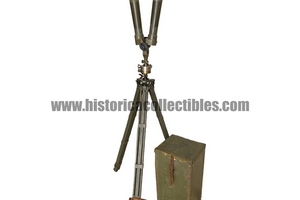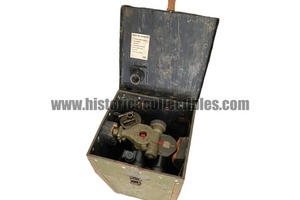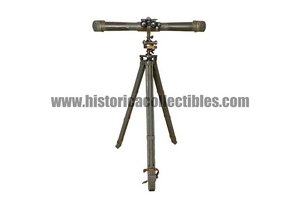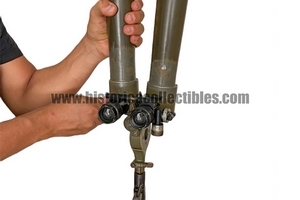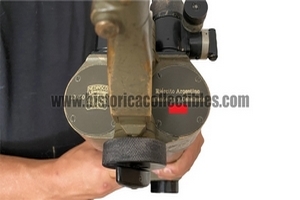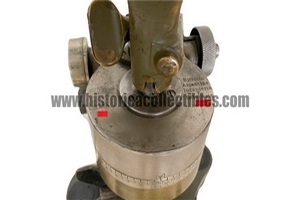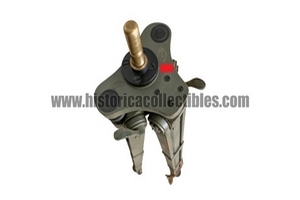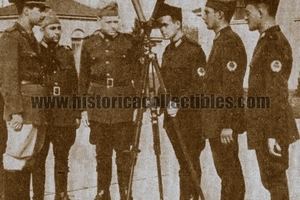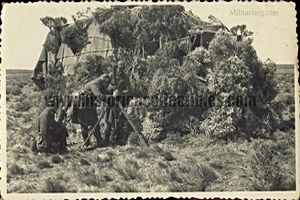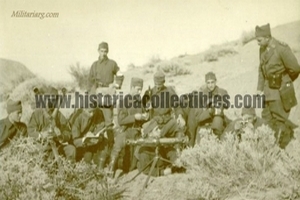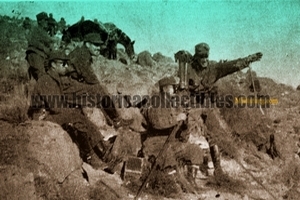Scherenfernrohr Zeiss Nedinsco, Camouflage, "Argentine Army - Infantry and Cavalry", circa 1938
Scissor periscope or Scherenfernrohr, mod. S.F.14, produced by Carl Zeiss Jena Nedinsco 's-Gravenhage around 1938, and intended for the Infantry and Cavalry of the Argentine Army.
In fact, the following information is shown on the right eyepiece plate; "Ejèrcito Argentino - Infanteria y Caballeria" (Argentine Army - Infantry and Cavalry) and military assignment number "XX".
On the left eyepiece plate there is information relating to the manufacturer "Carl Zeiss Jena Nedinsco 's-Gravenhage" as well as the magnifications and a number "XXX" (probably the serial number).
It is complete not only with the original tripod produced by "Optal" which bears the acceptance marks of the Argentine Army, but also with the Richtkreis which is marked with the military acceptance "Ejèrcito Argentino - Infanteria y Caballeria" and the manufacturer's mark "Carl Zeiss Jena Nedinsco 's-Gravenhage".
It is important to consider that both the Scherenfernrohr and the Richtkreis have the same serial number.
It is also equipped with the "screw support" useful for installing the Scherenfernrohr in conditions and places where it was not possible, or not convenient, to use the tripod.
In its original transport case there is the "Tabla de Contenido" (Table of Contents).
The "camouflage type" painting represents a real rarity in the optics sector, as it means that there was a specific request from the "client" to the manufacturing company for particular use needs, in fact camouflage is a type of painting which tends to camouflage the object in the environment in which it is used and an important factor since this was a trench optic it did not give the immediate possibility of establishing the exact distance to a possible enemy sniper present on that territory (the same principle that was used in the navy when camouflage paint was used on battleships).
These "camouflage" paint jobs could also be created on the battlefield if necessary to meet camouflage and difficult-to-identify needs.
The scherenfernrohr is in an excellent state of preservation and all mechanisms work properly. There is a reticle in the right eyepiece.
Nedinsco (Ned-Ins-Co in Dutch "Dutch Instrumentation Company") was founded in 1921 by Carl Zeiss of Jena following an acquisition of an old disused factory, located in the city of Venlo, Holland. Thanks to a man, Franz Kaumanns, who sympathized with Germany, Carl Zeiss managed to avoid the restrictions imposed in the Treaty of Versailles, in which Germany was not allowed to produce war material for its army; Article 168-170 in fact imposed rigorous controls on the production of war material and the consequent export.
In the same year the production of rangefinders, periscopes and signal lamps for military use began.
In 1921 Franz Kaumanns, as delegate representative of Carl Zeiss in the Netherlands, opened the corporate and representative headquarters in the city of Gravenhage.
In 1923, Zeiss entrusted the architect Hans Schlag with the task of designing the expansion of the factory, building a tower suitable for aligning the optical instruments and calibrating them over longer distances, focusing on the bell towers of Venlo, which this city boasted a large number of them.
In 1944 the factory was destroyed by a violent bombing.
After World War II, Nedinsco became an independent company.
In the same year the production of rangefinders, periscopes and signal lamps for military use began.
In 1921 Franz Kaumanns, as delegate representative of Carl Zeiss in the Netherlands, opened the corporate and representative headquarters in the city of Gravenhage.
In 1923, Zeiss entrusted the architect Hans Schlag with the task of designing the expansion of the factory, building a tower suitable for aligning the optical instruments and calibrating them over longer distances, focusing on the bell towers of Venlo, which this city boasted a large number of them.
In 1944 the factory was destroyed by a violent bombing.
After World War II, Nedinsco became an independent company.
Carl Zeiss takes its name from its founder, Carl Zeiss, who on November 17, 1846 chose the small town of Jena, in Thuringia, as the location for his precision optical equipment factory.
Thanks to the severe quality control that Carl Zeiss imposed on his products, going so far as to personally destroy the microscopes that did not pass the tests, the newly formed Zeiss became the official supplier of the University of Jena and received the gold medal of the industrial exhibition in 1861 of Thuringia as the best research instrument produced in Germany, awarded to the Stand I microscope of 1857.
In 1866 the thousandth microscope was produced and the name Zeiss became known in all European scientific circles. Thanks to studies on the Porro prism, in 1893 Abbe patented double prism binoculars, which accentuated the perception of depth.
The mass production of Zeiss binoculars began in 1894, already at the beginning of the twentieth century more than 30,000 were made, at the beginning of the First World War the quota had risen to 500,000 and, at the end of the Second World War, as many as 2,260,000 were produced binoculars for the civil and military market. Models were made starting from 4x11 mm to 12x40 mm, up to real giants such as the 80 mm and 100 mm.
Thanks to studies conducted on the perception of light in low light situations, it was demonstrated that the average dilation of the pupil in an adult is approximately 7 mm. For this reason, the 7x50 mm model was introduced in 1910 and remained on the market until 1917 with few changes to the materials used.
In 1926, following the post-war crisis of the First World War with the Treaty of Versailles which bankrupted many important German companies, Zeiss purchased "C.P. GOERZ" and founded Zeiss Ikon in 1926.
In 1937 Zeiss had commercial contacts and factories in more than 29 countries around the world. From '33 Zeiss acquired interest from the Nazi regime, which balanced production towards military instruments.
It successfully produced binoculars with wide-angle optics for military use, pressure-resistant optical systems for U-boats, periscope binoculars for targeting tanks. Furthermore, Zeiss cameras were mounted on the V2s for remote sensing operations of the English coasts.
On 1 November 1935, Zeiss, in the figure of Alexander Smakula, patented a process for the treatment of optical glass with extraordinary results in terms of light transmission. Remained a military secret until 1939, it was adopted on binoculars to reduce ghost images and internal reflections.
During the Second World War, there were numerous bombings against the Zeiss factories. Jena was bombed several times by the Allies starting in 1944. Stuttgart was razed to the ground, although the Contessa-Nettel factory suffered little damage. The bombing of Dresden, in addition to devastating the city, also caused considerable damage to the Zeiss Ikon headquarters.
On April 13, 1945, American military forces entered Jena, surprising themselves that the bombing had not caused any significant damage. The main planetarium was in ruins, while the factories remained operational.

